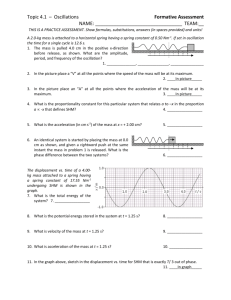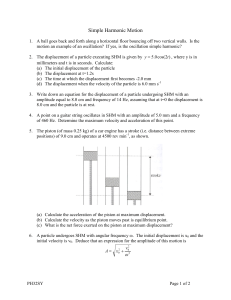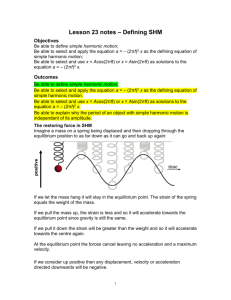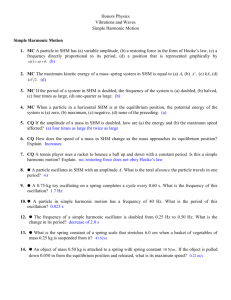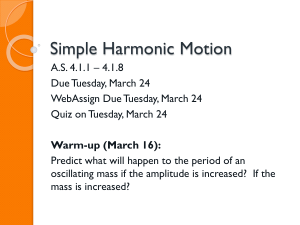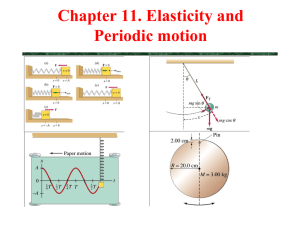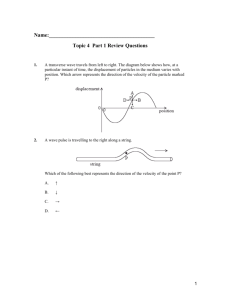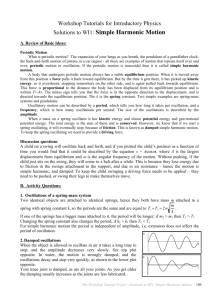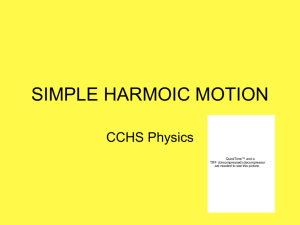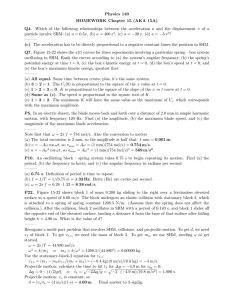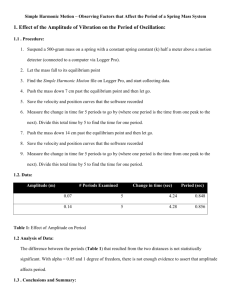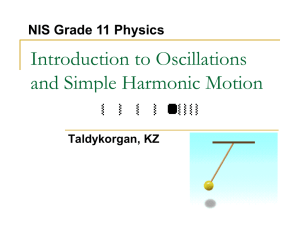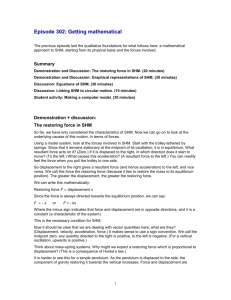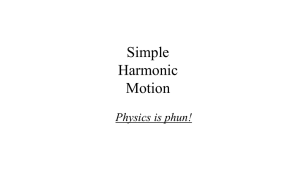Oscillations - curtehrenstrom.com
advertisement
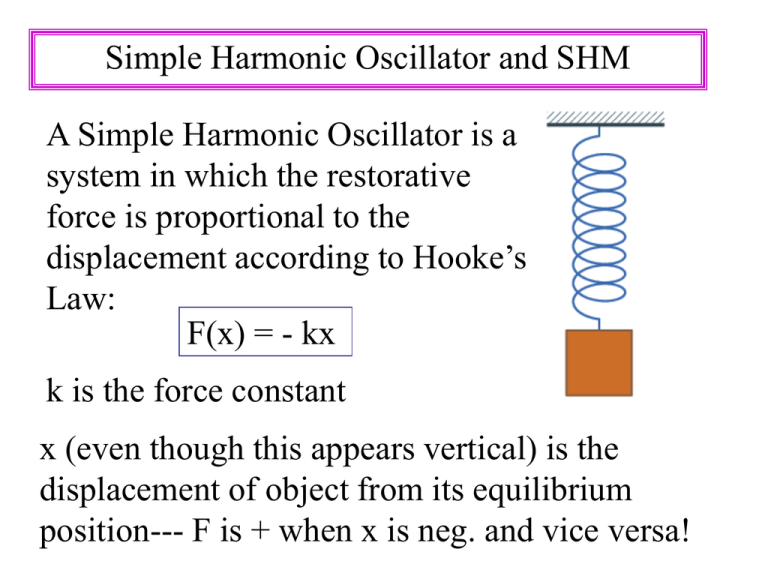
Simple Harmonic Oscillator and SHM A Simple Harmonic Oscillator is a system in which the restorative force is proportional to the displacement according to Hooke’s Law: F(x) = - kx k is the force constant x (even though this appears vertical) is the displacement of object from its equilibrium position--- F is + when x is neg. and vice versa! Because the force will vary with x, so does the acceleration and velocity! Frequency (f or γ) : number of cycles per second [Hz] Period (T): time to complete one full cycle [s] f = 1/ T +x t -x x = xmcos(t + ø) the angular frequency of the motion (rad/s) Angular frequency differs from the frequency by a factor of 2π : = 2π xm = maximum displacement (amplitude [A]) ø = phase constant (position of the object when at t = 0 s – phase shift of the cosine curve) Phase and phase constant: x = xmcos(t + ø) Phase: the angle over which the function repeats itself-- (t + ø) Phase constant (ø) is the shift of the function if x ≠ xm at t = 0 s ø=0 ø = π/2 The graph of an object moving in SHM is shown. The object has a maximum displacement of 6.3 m and is displaced 2.9 m at t = 0 s. What must be the phase constant of this motion? A = 6.3 m x(t) = Acos(ωt + ø) 2.9 = 6.3cos(ω(0) + ø) ø = cos-1 (.46) ø = 1.1 rad or 5.2 rad Because the graph is increasing after t = 0 s the correct value is 5.2 rad Displacement: Velocity: x(t) = Acos(t + ø) v(t) = -Aωcos(t + ø) Acceleration: vmax = Aω a(t) = -Aω2cos(t + ø) = -ω2x amax = Aω2 F = ma = -mω2x - mω2x = - kx ω= k m T = 2π T = 2π m k A body oscillates with simple harmonic motion such that x = (6.12 m)cos[(8.38 rad/s)t + 1.92 rad] For t = 1.90 s, find A) the displacement B) the velocity C) the acceleration D) the frequency and E) the period. The scale of a spring balance is marked from 0 to 25.0 N over 14.0 cm. A package suspended from the balance oscillates with a frequency of 2.00 Hz. What is the weight of the package? A 2.14 kg object hangs from a spring. A 325 g body is attached to the object and the spring stretches an additional 1.80 cm. The 325 g mass is removed and the spring is set into oscillation. Find the period of oscillation. A block is on a horizontal surface (a shake table) that is moving horizontally with a simple harmonic motion of frequency 2.35 Hz. The coefficient of static friction between the block and the table surface is .630. How great can the amplitude be if the block does not slip along the surface? If the block is not slipping then it is experiencing SHM and Fmax or = to fs Fmax = mamax a = 2xmax answer = 2.83 cm In harmonic motion (including SHM), ignoring any dissipative forces, the mechanical energy is conserved: E=K+U In SHM, x = xmcos(t + ø), so Pot. Energy is: U = .5kx2 = .5kxm2 cos2(t + ø) K = .5mv2 = .5m 2xm2 sin2 (t + ø) At the point of max displacement, the velocity of E = .5kxm2 the object will be 0 and therefore: An oscillating block-spring system has mechanical energy of 1.18 J, an amplitude of 9.84 cm and a max speed of 1.22 m/s. Find A) the force constant of the spring B) the mass of the block and C) the frequency of oscillation. A 5.13 kg object moves on a horizontal frictionless surface under the influence of a spring with a force constant of 9.88 N/cm. The object is displaced 53.5 cm and given an initial velocity of 11.2 m/s back toward the equilibrium position. Find A) the frequency of motion B) the initial potential energy of the system C) initial kinetic energy and D) amplitude of the motion. Applications of SHM 1) The Torsional Oscillator: A disk suspended by a wire and is twisted: When twisted, the tension provides a restoring torque: τ = -kθ T = 2π I k 2) The Simple Pendulum-- all of the mass is located in the bob: When the displacement angle is small (< 15˚) : T = 2π L g 3) The Physical Pendulum-- an oscillating body: T = 2π I mgh h is dist. from cm to PP A circular hoop with a mass of 2.16 kg and a radius of 65.3 cm is suspended from a horizontal nail. What is the frequency of oscillation for small displacements from equilibrium? A physical pendulum consists of a meterstick that is pivoted about a small hole that is x cm from the 50.0 cm mark and observed to have a period of oscillation of 2.50 s. What is x? A 2500 kg wrecking ball is suspended from a 17.3 m cable. What would be its frequency of oscillation for a small displacement?
